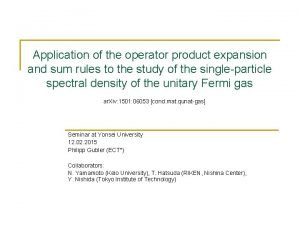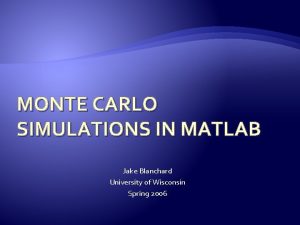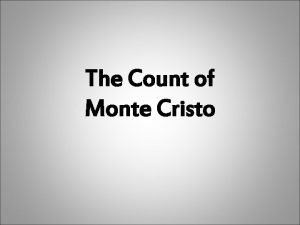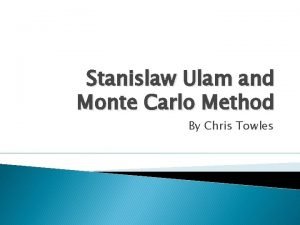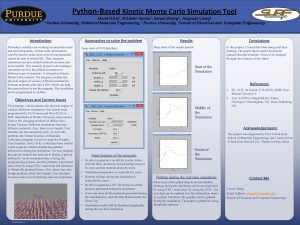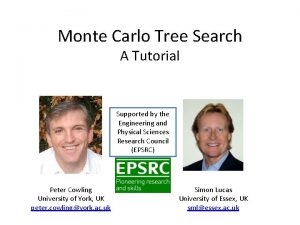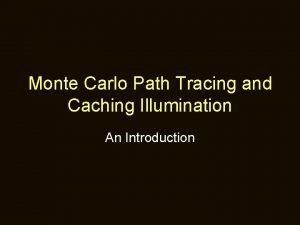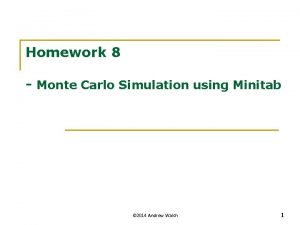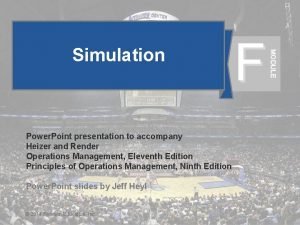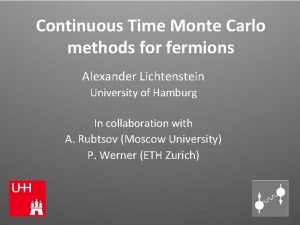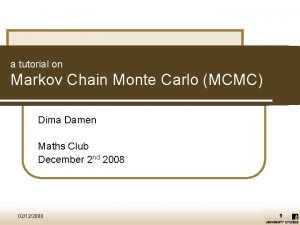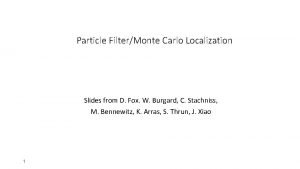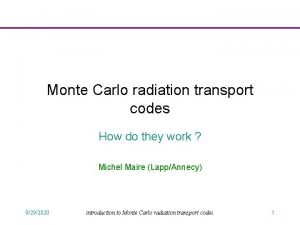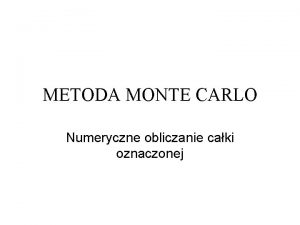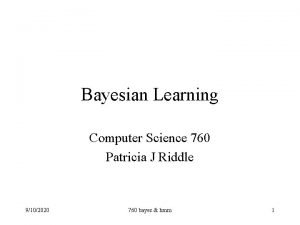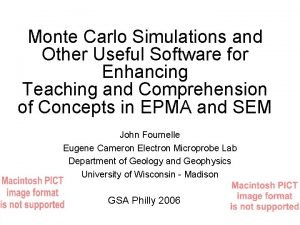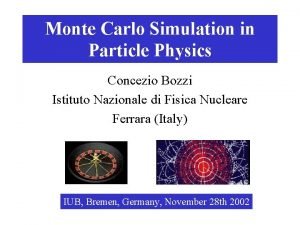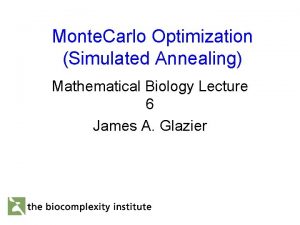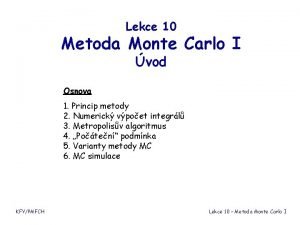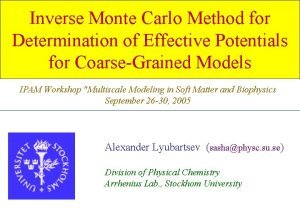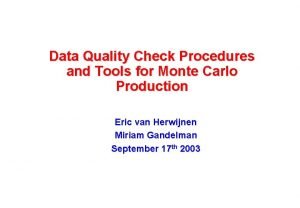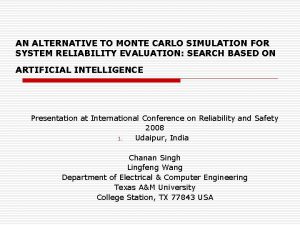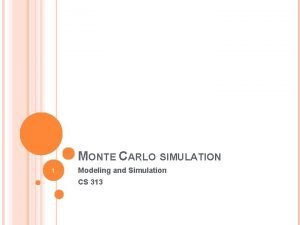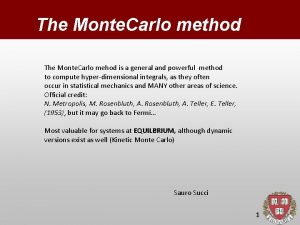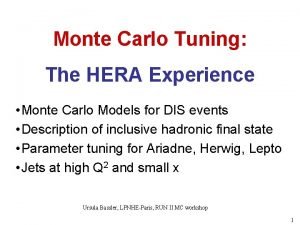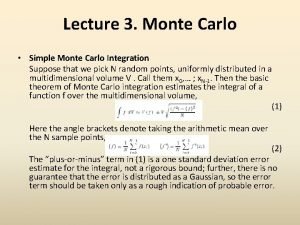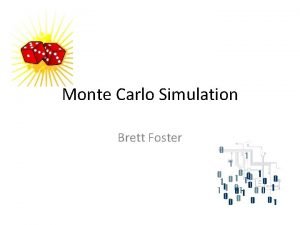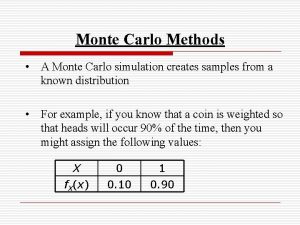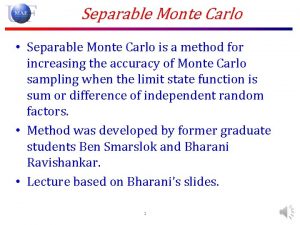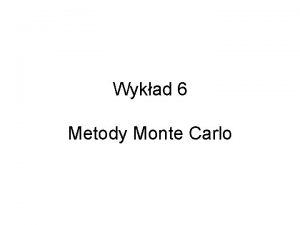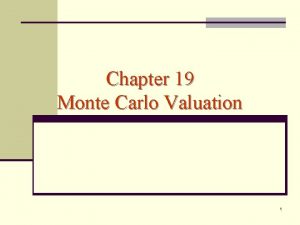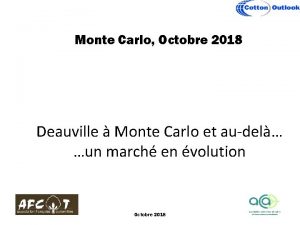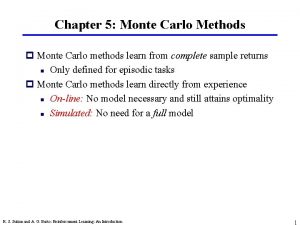Multicomponent quantum Monte Carlo method Quantum Monte Carlo








![3. Method: Jastrow factor (1) Jastrow factor in trial wave function[1]: : We introduced 3. Method: Jastrow factor (1) Jastrow factor in trial wave function[1]: : We introduced](https://slidetodoc.com/presentation_image_h2/895e7e5925643d9e98e111cfa577797b/image-9.jpg)




![4. Result: [Li. H; e+] system + Total energy of [Li. H; e ] 4. Result: [Li. H; e+] system + Total energy of [Li. H; e ]](https://slidetodoc.com/presentation_image_h2/895e7e5925643d9e98e111cfa577797b/image-14.jpg)
![4. Result: positron affinity of Li. H Positron affinity [PA] of Li. H →PALi. 4. Result: positron affinity of Li. H Positron affinity [PA] of Li. H →PALi.](https://slidetodoc.com/presentation_image_h2/895e7e5925643d9e98e111cfa577797b/image-15.jpg)
![4. Result: [HCN; e+] system Total energy of [HCN; e+] with various schemes - 4. Result: [HCN; e+] system Total energy of [HCN; e+] with various schemes -](https://slidetodoc.com/presentation_image_h2/895e7e5925643d9e98e111cfa577797b/image-16.jpg)
![4. Result: Positron affinity of HCN Positron affinity [PA] of HCN molecule: →PAHCN= EHCN 4. Result: Positron affinity of HCN Positron affinity [PA] of HCN molecule: →PAHCN= EHCN](https://slidetodoc.com/presentation_image_h2/895e7e5925643d9e98e111cfa577797b/image-17.jpg)









![Result: positronium [Ps] Positronium: ・The system contains only one-electron and one-positron. Total energy of Result: positronium [Ps] Positronium: ・The system contains only one-electron and one-positron. Total energy of](https://slidetodoc.com/presentation_image_h2/895e7e5925643d9e98e111cfa577797b/image-27.jpg)


- Slides: 29

Multi-component quantum Monte Carlo method ~Quantum Monte Carlo study on multi-component systems~ ○Yukiumi KITA 1, Ryo MAEZONO 2, 3, Masanori TACHIKAWA 1 1 Yokohama City University, Japan 2 School of Information Science, Japan Advanced Institute of Science and Technology 3 Precursory Research for Embryonic Science and Technology, Japan Science and Technology Agency, Japan 1

In this talk… 1 st Topic: Ab Initio Quantum Monte Carlo Study on the Positronic Compounds QMC calculation of the temporary bound state between a positron and atoms/molecules 2 nd Topic: Development of Translational and Rotational Free Quantum Monte Carlo Method QMC calculation of the system which contains only quantum particles 2

1 st Topic: Ab Initio Quantum Monte Carlo Study on the Positronic Compounds 3

Outline of the 1 st topic 1. Introduction - Positron & Positronic compound Pair annihilation 2. Purpose 3. Methods 4. Results [H-, e+] - [Li. H; e+] system - [HCN; e+] system [Li. H, e+] 5. Summary [HCN, e+] 4

1. Introduction: positron Positron (e +): ・A positron was found by C. D. Anderson in 1932. ・A positron is an antiparticle of an electron (e-) (charge= +1, mass= 1, spin= 1/2) Positronic When a positron meet a molecule (atom), they form the positronic compounds: compound which is the temporary bound state of them. e+ e+ e- e- Nuc. [X-] Nuc. [X-; e+] Conventional MO scheme gives poor results. We need the more accurate theoretical method for the positronic compound. Electronic & Positronic Structure ? Stable Geometry ? ? 5

2. Purpose 1. The development of the quantum Monte Carlo method which can obtain the accurate many-body wave function of the positronic compound. 2. Theoretical analysis on the positronic compounds by this method. - e. g. [M; e+] (M= H-, Li. H, Na. H, KH, HF etc. ) 6

3. Method: trial wave function Hamiltonian of a positronic compound : We assumed the Hamiltonian of the system containing M nuclei, N electrons and a positron as the following form: where V(R) is the Coulomb interaction potential between charged particles: e--Nuc. e+-Nuc. e--e- e--e+ Trial wave function in QMC method: Slater-Jastrow type function Hartree-Fock node : Jastrow function : single determinant of spin up/down electrons : a positronic orbital [1] M. Tachikawa, H. Sainowo, K. Iguchi, and K. Suzuki; J. Chem. Phys. 101 5925 (1994) 7

3. Method: e--Nuc. cusp correction LCAO-expansion of e-/e+ orbitals by Gaussian basis : We used the Gaussian basis set for expanding e -/e+ orbitals. electrons: e--Nuc. cusp cannot be described well. positron : [1] e--Nuc. cusp correction for Gaussian type orbital : The partial substitution of s-type GTO within cusp-radii [ rc] r. C: cusp-radii GTO cusp Cusp-corrected GTO [1] A. Ma , M. D. Towler, N. D. Drummond and R. J. Needs; J. Chem. Phys. , 122, 224322 (2005) 8
![3 Method Jastrow factor 1 Jastrow factor in trial wave function1 We introduced 3. Method: Jastrow factor (1) Jastrow factor in trial wave function[1]: : We introduced](https://slidetodoc.com/presentation_image_h2/895e7e5925643d9e98e111cfa577797b/image-9.jpg)
3. Method: Jastrow factor (1) Jastrow factor in trial wave function[1]: : We introduced the Jastrow factor proposed by Needs group into the trial wave function, e--e+ e--Nuc. e--e--Nuc. e+-Nuc. [1] N. D. Drummond, M. D. Towler and R. J. Needs; Phys. Rev. B, 70, 235119 (2004) 9

3. Method: Jastrow factor (2) All Jastrow factors are expaned in terms of the distance between particles[1]: where, and Γ is the parameter based on the cusp condition such as: [1] N. D. Drummond, M. D. Towler and R. J. Needs; Phys. Rev. B, 70, 235119 (2004) 10

3. Method: diffusion Monte Carlo ・Importance-sampled DMC method → which propagates the following distribution in imaginary time τ. ・Fixed-node approximation trial node → used on only electron-moves Fig. produced by R. Maezono ・Stabilization scheme by Umrigar, Nightingale and Runge[1] - Effective time step - Drift vector limiting scheme (for only electrons) - Local energy limiting scheme [1] C. J. Umrigar, M. P. Nightingale, K. J. Runge; J. Chem. Phys. , 99, 2865 (1993) 11

Code implementation We modified CASINO-code developed in Cavendish Laboratory, University of Cambridge. Main authors of CASINO (ver. 1. 8. 1) : R. J. Needs, M. D. Towler, N. D. Drummond and P. R. C. Kent ( http: //www. tcm. phy. cam. ac. uk/~mdt 26/cqmc. html ) 12

Outline of the 1 st topic 1. Introduction - Positron & Positronic compound Pair annihilation 2. Purpose 3. Methods 4. Results [H-, e+] - [Li. H; e+] system - [HCN; e+] system [Li. H, e+] 5. Summary [HCN, e+] 14
![4 Result Li H e system Total energy of Li H e 4. Result: [Li. H; e+] system + Total energy of [Li. H; e ]](https://slidetodoc.com/presentation_image_h2/895e7e5925643d9e98e111cfa577797b/image-14.jpg)
4. Result: [Li. H; e+] system + Total energy of [Li. H; e ] with various schemes e-/e+ orbitals in HF-level - RLi-H= 1. 771Å which is the optimized value by explicitly correlated gaussian method (Ref. 2) - Unit in a. u. -7. 990367 MCMO(HF) [ e-/e+= 6 -311++G(df, pd)/9 s 8 p ] [ VMC e-/e+= [ [1] [6 -311 G**+diffuse+polar+ghost] 6 -311++G(df, pd)/9 s 8 p ] FN-DMC e-/e+= -8. 08058(7) -8. 05530 CISD -8. 10701(5) 6 -311++G(df, pd)/9 s 8 p ] -8. 1071(1) -8. 107474 Fixed-node Approximation FN-DMC [2] Explicitly Correlated Gaussian [3] [1024 terms] [1] K. Strasburger; Chem. Phys. Lett. 253 49 (1996), [2] D. Bressanini; J. Chem. Phys. 113 6154 (2001). [3] K. Strasburger; J. Chem. Phys. 114 615 (2001) 15
![4 Result positron affinity of Li H Positron affinity PA of Li H PALi 4. Result: positron affinity of Li. H Positron affinity [PA] of Li. H →PALi.](https://slidetodoc.com/presentation_image_h2/895e7e5925643d9e98e111cfa577797b/image-15.jpg)
4. Result: positron affinity of Li. H Positron affinity [PA] of Li. H →PALi. H= ELi. H – ELi. H; e+ DMC VMC ECG [2] CISD [1] Positron affinity of Li. H [e. V] HF [1] K. Strasburger; Chem. Phys. Lett. 253 49 (1996) [2] K. Strasburger; J. Chem. Phys. 114 615 (2001) HF VMC DMC CISD ECG +0. 04(11) +0. 505(3) +1. 007(2) +0. 462 +1. 005 16
![4 Result HCN e system Total energy of HCN e with various schemes 4. Result: [HCN; e+] system Total energy of [HCN; e+] with various schemes -](https://slidetodoc.com/presentation_image_h2/895e7e5925643d9e98e111cfa577797b/image-16.jpg)
4. Result: [HCN; e+] system Total energy of [HCN; e+] with various schemes - The structure of HCN is optimized by the second-order perturbation method - Unit in a. u. (MP 2/aug-cc-p. VTZ) MCMO(HF) -92. 90074 [ e-/e+= 6 -311++G(2 d, 2 p)/15 s 15 p 6 d 2 f ] -92. 901915 CISD [1] [ e-: 6 -311++G(2 d, 2 p) e+: 6 -311++G(2 d, 2 p) + 10 s GTF (off-atom)] [ [ e-/e+= VMC 6 -311++G(2 d, 2 p)/15 s 15 p 6 d 2 f ] FN-DMC e-/e+= -93. 2591(5) -93. 39830(8) 6 -311++G(2 d, 2 p)/15 s 15 p 6 d 2 f ] 72% HOMO/e+ orbitals in HF-level 100% [1] H. Chojnacki and K. Strasburger, Mol. Phys. 104 2273 (2006) 17
![4 Result Positron affinity of HCN Positron affinity PA of HCN molecule PAHCN EHCN 4. Result: Positron affinity of HCN Positron affinity [PA] of HCN molecule: →PAHCN= EHCN](https://slidetodoc.com/presentation_image_h2/895e7e5925643d9e98e111cfa577797b/image-17.jpg)
4. Result: Positron affinity of HCN Positron affinity [PA] of HCN molecule: →PAHCN= EHCN – EHCN; e+ DMC CISD [1] HFVMC Positron affinity of HCN [e. V] VMC [1] H. Chojnacki and K. strasburger, Mol. Phys. 104 2273 (2006) HFVMC 0. 0(9) VMC -0. 22(2) DMC +0. 026(2) CISD[1] +0. 018 18

5. Summary of 1 st topic 1. We had developed the Multi-Component Quantum Monte Carlo [MC_QMC] method which can obtain the many-body wave function containing the several kinds of particle such as e- and e+. 2. We had applied MC_QMC method to [Li. H; e+] and [HCN; e+] systems. In benchmark models: [Li. H; e+] Positron affinity gives good agreement with the results by the variational calculation using ECGs trial wave function. In [HCN; e+] system, Our result gives the lowest variational energy of [HCN; e +], shows that HCN molecule can bind a positron. 19

2 nd Topic: Development of Translational and Rotational Free Quantum Monte Carlo Method 20

Nuclear quantum effects The quantum nature of the light particle (proton and deuteron etc. ) has important effects on the many research fields. Representative topics include the hydrogen[H]/deuterium[D ] isotope effect observed in ・red-shift of vibrational frequencies, ・shift of chemical reaction rates etc. Especially, in hydrogen cluster and its isotope (H 2, HD and H 3+ etc. ), the nuclear quantum effect strongly affects its properties. The system contains only quantum particles, that is, electrons and quantum nuclei. 21

Theoretical approaches On theoretical analysis of the system which contains only quantum particles, one of the smart approach is the use of the internal coordinate. e. g. the use of relative distances between quantum particles st topic, we used the trial wave function However, in our method shown in 1 with one-particle Gaussian basis sets. the trial wave function depends on the laboratory coordinate system We need the other theoretical frameworks… 22

What is problems? Non-relativistic Hamiltonian of the systems which do not contain any point charges: Kinetic energy Coulomb interaction Under this Hamiltonian, if we used the trial wave function depending on the laboratory coordinate system, fatally contains the translational and rotational energy of whole system in its kinetic energy. Leading to the difficulty of analyzing the variational energy of the system… 23

Translational & Rotational-Free Hamiltonian Translational and Rotational Free Hamiltonian: To remove the needless kinetic energy, we introduced modified Hamiltonian as follows: “Conventional” Hamiltonian Translational energy of whole system (kinetic energy of the center of mass) Rotational energy of whole system around the center of mass Total mass Tensor of moment of inertia in Co. M-system Total momentum Total angular momentum in Co. M-system 24

Trial wave function In TRF-QMC method, we used Slater-Jastrow trial wave function in which the orbital parts are expanded by one-particle Gaussian basis sets. ・Hartree-Fock method[1] ・one-particle Gaussian basis depending on relative distances Orbital parts depending on Lab. coordinate system : Jastrow function : spin of ν-th component : Slater determinant for the particle with spin Sν Jastrow function : We used Jastrow function with the cutoff length proposed by Drummond [2] ※only two-body terms [1] M. Tachikawa et al. ; J. Chem. Phys. 101 5925 (1994), [2] N. D. Drummond, M. D. Towler and R. J. Needs; Phys. Rev. B, 70, 235119 (2004) 25

Variational Monte Carlo method In VMC method, we evaluate the translational & rotational free local energy at the configurations which are distributed according to ELTRF contains the local translational and rotational energy as follows: For the translational energy of the center of mass: For the rotational energy of whole system around the center of mass: 26

diffusion Monte Carlo method In diffusion Monte Carlo method, we need the Green function corresponding to … But, not yet… 27
![Result positronium Ps Positronium The system contains only oneelectron and onepositron Total energy of Result: positronium [Ps] Positronium: ・The system contains only one-electron and one-positron. Total energy of](https://slidetodoc.com/presentation_image_h2/895e7e5925643d9e98e111cfa577797b/image-27.jpg)
Result: positronium [Ps] Positronium: ・The system contains only one-electron and one-positron. Total energy of the ground state TF: Translational Free TRF: Translational & Rotational Free Energy [a. u. ] -0. 18908(4) Conv. VMC -0. 249476(9) TF-VMC -0. 249627(7) TRF-VMC -0. 25 exact ・VMC: the total energy are improved by removing the translational and rotational energies. ・DMC: not yet 28

Result: HD HD: The system contains two-electrons, one-proton 、one-deuteron. Total energy of the ground state TF: Translational Free TRF: Translational & Rotational Free Energy [a. u. ] -1. 1117(2) Conv. VMC -1. 1271(2) TF-VMC -1. 1407(2) TRF-VMC [1] -1. 16547 Explicitly Correlated Gaussian ・VMC: the total energy are improved by removing the translational and rotational energies. ・DMC: not yet [1] Donald B. Kinghorn and Ludwik Adamowicza. ; J. Chem. Phys. 113 4203 (2000) 29

Summary We have proposed an another quantum Monte Carlo technique to calculate the system which contains only quantum particles. In this method, ・we can use one-particle Gaussian basis sets. leading to the easiness to generate the trial wave functions ・we remove the translational and rotational energy of whole system We found that the total energy of Ps and HD are improved by the translational and rotational free VMC method. However, we need the diffusion Monte Carlo technique for obtaining the sufficiently accurate results. 30
 Quantum monte carlo
Quantum monte carlo Monte carlo integration matlab
Monte carlo integration matlab Count of monte carlo
Count of monte carlo Stanislaw ulam monte carlo
Stanislaw ulam monte carlo Metode monte carlo dan contohnya
Metode monte carlo dan contohnya Mnemstudio
Mnemstudio Kinetic monte carlo python
Kinetic monte carlo python Mcts tutorial
Mcts tutorial Monte carlo path tracing
Monte carlo path tracing Monte carlo localization for mobile robots
Monte carlo localization for mobile robots Monte carlo in minitab
Monte carlo in minitab Monte carlo simulation advantages and disadvantages ppt
Monte carlo simulation advantages and disadvantages ppt Continuous time monte carlo
Continuous time monte carlo Markov chain monte carlo tutorial
Markov chain monte carlo tutorial Monte carlo localization python
Monte carlo localization python Monte carlo radiation transport
Monte carlo radiation transport Metoda monte carlo algorytm
Metoda monte carlo algorytm Viterbi algorithm
Viterbi algorithm Monte carlo search tree
Monte carlo search tree Monte carlo simulation freeware
Monte carlo simulation freeware Monte carlo simulation particle physics
Monte carlo simulation particle physics Monte carlo optimization
Monte carlo optimization Metoda monte carlo
Metoda monte carlo Inverse monte carlo
Inverse monte carlo Villa monte carlo
Villa monte carlo Monte carlo data quality
Monte carlo data quality Monte carlo simulation alternatives
Monte carlo simulation alternatives Monte carlo
Monte carlo Monte carlo truth
Monte carlo truth Equilikely
Equilikely
